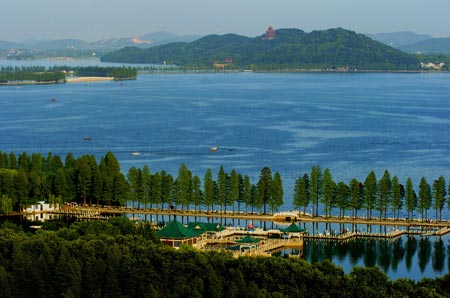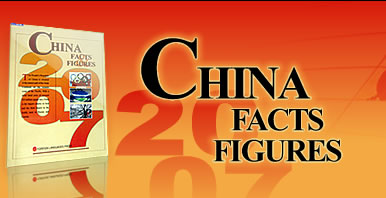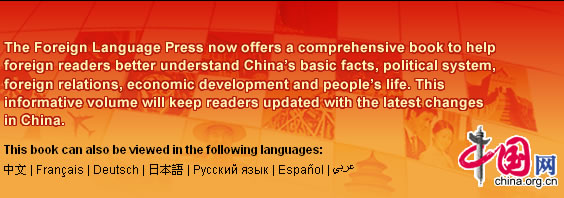China's environmental quality was generally stable in 2006. The rapid increase in the discharge of major pollutants was initially curbed, efforts to protect and improve the ecological environment were intensified, and the public's awareness of environmental protection was obviously raised. However, environmental protection remained a daunting task.
 |
Being close to the Olympic venues, the Fifth Ring Road in Beijing earns itself a nickname—"Olympic Avenue" or "Environment Friendly Avenue." "Green Olympics" is one of the three themes of the Beijing 2008 Olympic Games.
Freshwater Quality
Of the 408 monitored sections of the seven major river systems in China, 46 percent met the national quality standard of Grade III for surface water, 28 percent met the quality standard of Grade IV or V, and 26 percent were below Grade V. Compared with the previous year, there was no obvious change in the water quality in China's seven major river systems.
 |
Tourists are paddling by potted flowers in a lake in Jinan Arboretum. The potted flowers can purify the water while beautifying the environment.
Seawater Quality
Monitoring of oceanic water quality at 288 offshore monitoring stations indicated that oceanic water met the national quality standard of Grade I and II in 67.7 percent of the stations, up 0.4 percentage points from the previous year; water at 8 percent of the stations met Grade III standard, down 0.9 percentage points; and water with Grade IV or inferior quality was found in 24.3 percent of the stations, up 0.5 percentage points. A total of 149,000 square km of water did not meet the quality standard for clean oceanic water, 10,000 square km more than the previous year. Of this total, seriously polluted oceanic area occupied about 29,000 square km.
Water Quality in China's Terrestrial Seas
Bohai Sea Pollution in the sea remained severe. The area where water failed to meet the quality standard for clean oceanic water came to 20,000 square km, making up 26 percent of Bohai's total acreage and maintaining the same level as in 2005. Marine areas where water quality fell into categories of severe pollution, medium pollution, less pollution and relatively good quality were 3,000 square km, 2,000 square km, 7,000 square km and 8,000 square km, respectively. Areas where seawater quality fell into categories of severe pollution and less pollution each increased about 1,000 square km over 2005. The most heavily polluted areas were mainly concentrated in the Bohai Bay, the Laizhou Bay and coast of the Liaodong Bay, with major pollutants being inorganic nitrogen, phosphate and lead. Experts attribute Bohai's pollution mainly to the inflow of a large amount of pollutants from land and poor water cycle in the sea.
 |
A functional green barrier has been built in Hebei Province to harness the sandstorm sources of Beijing and Tianjin. The air quality in the two cities is tightened up.
Yellow Sea The area where water failed to meet the quality standard for clean oceanic water totaled 43,000 square km, maintaining the same level as 2005. Marine areas where water quality fell into categories of severe pollution, medium pollution, less pollution and relatively good quality accounted for 9,000 square km, 5,000 square km, 12,000 square km and 17,000 square km, respectively. Severely polluted marine area expanded considerably compared with 2005. The most heavily polluted areas were mainly concentrated in the estuary of the Yalujiang River and the coast of Jiangsu Province, with major pollutants being inorganic nitrogen, phosphate and oil.
East China Sea The area where water failed to meet the quality standard for clean oceanic water spanned across 65,000 square km. Marine areas where water quality fell into categories of severe pollution, medium pollution, less pollution and relatively good quality were 15,000 square km, 8,000 square km, 23,000 square km and 21,000 square km, respectively. The most heavily polluted areas were mainly concentrated in the estuary of the Yangtze River, the Hangzhou Bay and the coast of Ningbo in Zhejiang Province, with major pollutants being inorganic nitrogen, phosphate and oil. Severely polluted marine area in the Yangtze estuary decreased slightly partly because of the decline in the discharge of the Yangtze River.
South China Sea The area where water failed to meet the quality standard for clean oceanic water came to 18,000 square km, an increase of 7,000 square km over 2005. Marine areas where water quality fell into categories of severe pollution, medium pollution, less pollution and relatively good quality were 2,000 square km, 2,000 square km, 10,000 square km and 4,000 square km, respectively. Major pollutants were inorganic nitrogen, phosphate and lead. The most heavily polluted areas were mainly concentrated in the estuary of the Pearl River and Zhanjiang Port.
Urban Pollution Treatment
In the 559 cities covered by an air quality monitoring program, 349 cities reached air quality standard Grade II or above, accounting for 62.4 percent of all cities under the program; 159 cities attained Grade III, accounting for 28.4 percent of the total; and 51 cities ranked Grade III minus, accounting for 9.1 percent. Of the 378 cities subject to a noise monitoring program, 5 percent enjoyed a good sound environment, 63.8 percent had a fairly good sound environment, 29.3 percent experienced light noise pollution, 1.6 percent had medium noise pollution and 0.3 percent suffered severe noise pollution.
 |
Wuhan places stress on the living environment and focuses on turning the city into an ecology friendly one.
Chemical oxygen demand reached 14.31 million tons in 2006, 1.2 percent higher than in the previous year. Sulfur dioxide emissions hit 25.94 million tons, up 1.8 percent over 2005.
At the end of 2006, the daily treatment capacity of municipal sewage reached 61.22 million cubic meters, up 6.9 percent year on year. The municipal sewage treatment rate was 56 percent, up 4 percentage points. The area covered by central heating networks reached 2.65 billion square meters, up 5.1 percent. The vegetation coverage rate in built-up areas reached 33.5 percent, up 1 percentage point.










